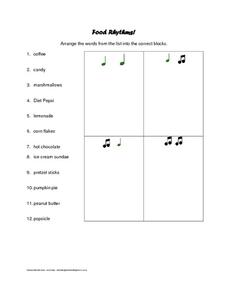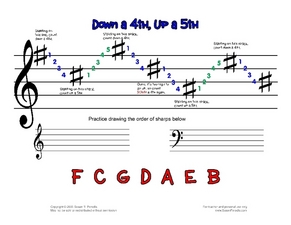Curated OER
Note Identification – Grade 1
In this musical note identification worksheet, students examine 8 musical notes and then respond to 4 questions that require them to identify notes and notes in common time.
Curated OER
Customized Handwriting: Sixteenth Note
In this customized handwriting: sixteenth note worksheet, 1st graders change the style, font and text, then print the worksheet to practice handwriting.
Curated OER
Food Rhythms
Kids note the rhythm of 12 words and then list each word in the appropriate box on a worksheet.
Curated OER
Code Breaker!
For this music notes worksheet, students decode a message with the letter names of notes. Students analyze the 8 labeled names of notes on the treble clef. Students write the letter names of each of 60 notes underneath the notes. A...
Curated OER
Ornament Notes
In this recognizing the musical notes on a staff learning exercise, students identify and color the notes according to the accompanying code. Students color 9 ornament notes.
Curated OER
Code Maker! Note Naming Activity
In this music notes learning exercise, learners come up with as many words possible using only the letters in the musical alphabet. Students then turn the letters into code by writing the words in music notes on the staff above the word.
Curated OER
Clef music note
In this clef music note worksheet, students view a picture of a clef music note and trace and write the word clef. Students trace and write the word 1 time each.
Curated OER
Down a 4th, Up a 5th
It's time to practice those sharps. Young musicians write the order of sharps by counting down a fourth and up a fifth. This is a great way to teach sharps to emergent musical note readers.
Curated OER
It All Adds Up
In this rhythmic values worksheet, students explore musical notes and their values. Students add the note values together to get a total number of beats for the two notes in each of the 30 sets of notes.
Fun Music Company
Treasure Island Clues: Rhythm
Designed for rhythm level 1, the two games in this packet ask young musicians to identify the number of beats represented by a series of notes and notations, and then to use those numbers to answer a music trivia question.
Curated OER
Treble Clef Lines and Spaces - 3
In this treble clef lines and spaces worksheet, learners read the sheet music and identify the letter names of the notes that are missing as they fill in 36 blank spaces.
Curated OER
Treble Clef Lines - 2
In this treble clef lines worksheet, young scholars read the sheet music and identify the letter names of the notes that are missing as they fill in 30 blank spaces.
Curated OER
Using the Internet - Art and Design
An interesting resource that might work best in an upper level art course, this handout provides a list of nine websites where young artists can read and study about all forms of art. These online resources range from a dictionary of...
Fun Music Company
Compound Time
To demonstrate their understanding of simple and compound time signatures, young musicians complete a chart by drawing quarter or dotted quarter notes equal in value to the note groups shown.
Fun Music Company
Working Out the Key
"Gimme an E minor!" Or any key for that matter. But how do you figure out the key of a piece of music? Here's a worksheet that shows young musicians three easy steps to help them identify the key of a piece of music.
Fun Music Company
Classification of Intervals
Major 2nd, Perfect 4th, Minor 3rd. The number and classification of intervals are the focus of a one-page worksheet that asks musicians to write the intervals above given notes and to indicate the classification of others.
Curated OER
Not the Note 1
In this music worksheet, students name twenty-five notes. As an example, the first five notes are already labeled for the students.
Curated OER
Name The Note
In this music instructional activity, middle schoolers name the notes on the sheet. They use the examples as a reference point to identify the notes on each bar.
Fun Music Company
Intervals
As part of their study of intervals, musicians are asked to draw the interval indicated above the notes provided on the worksheet.
Curated OER
Half Note: Print and Color
In this word recognition worksheet, students trace the word "half note", write the word independently, and color the picture of the half note.
Curated OER
Whole Note: Print adn Color
In this word recognition worksheet, students trace the words "whole note", write the words independently, and color the picture of the whole note.
Fun Music Company
Completing Measures with Rests
Rests. Eighth rests, quarter rests, and half rests are the focus of a one-page worksheet that asks music theory students to complete a series of measures with rests and bar lines.
Curated OER
Missing the Major Scales 2
Any musician can tell you, you have to know your scales, key signatures, and notes when reading sheet music. Kids are quizzed on major scales and the notes found with in each scale. They fill in the missing notes and identify each scale.
Curated OER
Fearless Flats
This handout gives budding musicians an opportunity to practice placing and identifying notes and flats. A mnemonic is used to help them remember the names of each note as it appears on the staff.

























